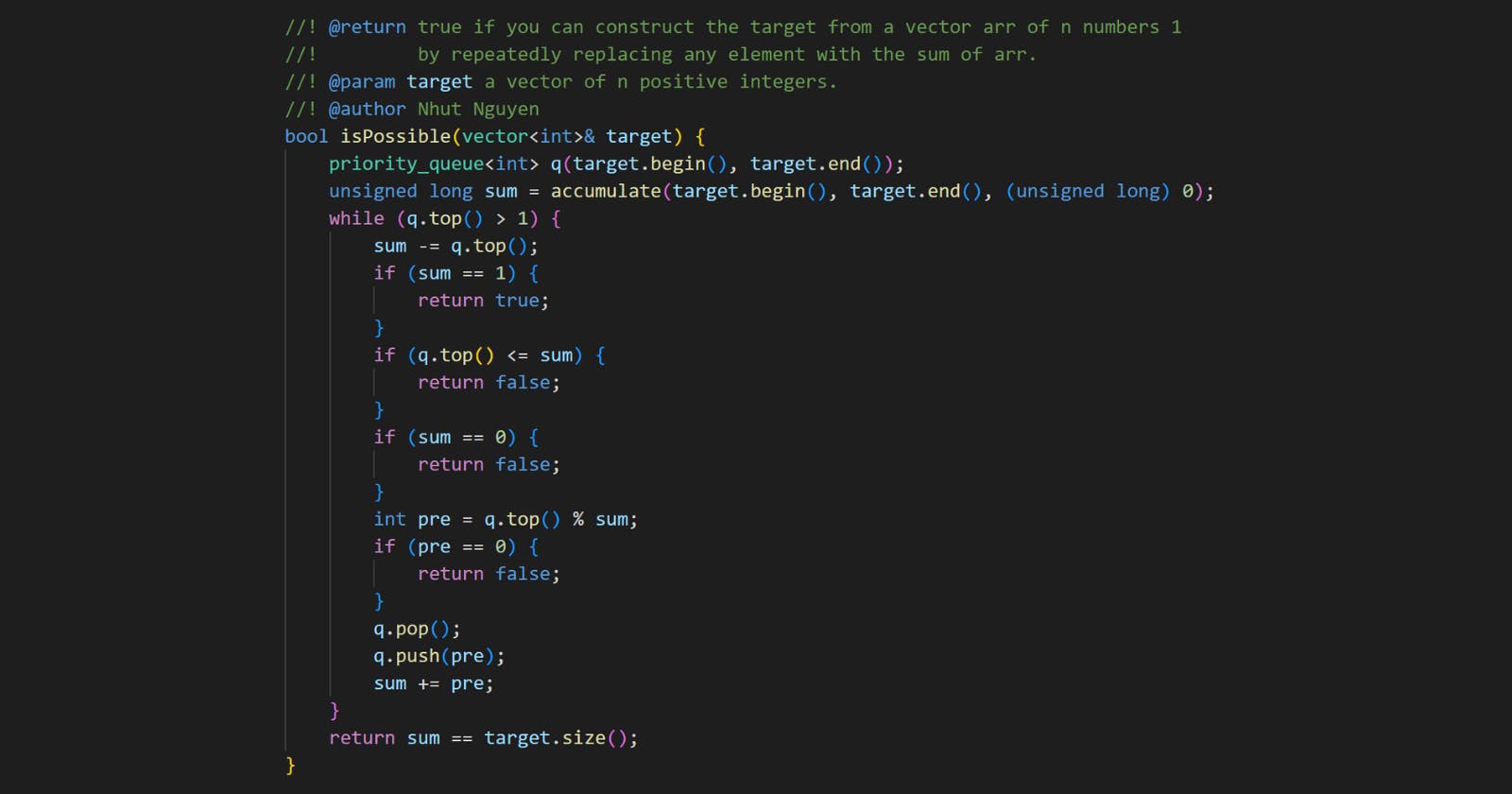Problem statement
You are given an array target of n integers. From a starting array arr consisting of n 1's, you may perform the following procedure:
Let
xbe the sum of all elements currently in your arrayarr.Choose any index
isuch that0 <= i < nand set the valuearr[i] = x.You may repeat this procedure as many times as needed.
Return true if it is possible to construct the target array from arr, otherwise, return false.
Example 1
Input: target = [9,3,5]
Output: true
Explanation: Start with arr = [1, 1, 1]
[1, 1, 1], sum = 3 choose index 1
[1, 3, 1], sum = 5 choose index 2
[1, 3, 5], sum = 9 choose index 0
[9, 3, 5] Done
Example 2
Input: target = [1,1,1,2]
Output: false
Explanation: Impossible to create target array from [1,1,1,1].
Example 3
Input: target = [8,5]
Output: true
Constraints
n == target.length.1 <= n <= 5 * 10^4.1 <= target[i] <= 10^9.
Solution 1: Going backward
If you start from arr = [1,1,...,1] and follow the required procedure, the new element x you get for the next state is always the max element of arr.
To solve this problem, you can start from the max element of the given target to compute its previous state until you get the arr = [1,1,...,1].
Example 1
For target = [9,3,5]:
The max element is
9, subtract it from the remaining sum:9 - (3 + 5) = 1, you gettarget = [1,3,5].The max element is
5, subtract it from the remaining sum:5 - (1 + 3) = 1, you gettarget = [1,3,1].The max element is
3, subtract it from the remaining sum:3 - (1 + 1) = 1, you gettarget = [1,1,1].Return
true.
Notes
If
target = [m,1]ortarget = [1,m]for anym >= 1, you can always turn it toarr = [1,1].If the changed value after the subtraction is still the max element of the previous state, you need to redo the subtraction at the same position. In this case, the modulo might be used instead of subtraction.
Code
#include <iostream>
#include <numeric>
#include <algorithm>
#include <vector>
using namespace std;
bool isPossible(vector<int>& target) {
unsigned long sum = accumulate(target.begin(), target.end(), (unsigned long) 0);
auto pmax = max_element(target.begin(), target.end());
while (*pmax > 1) {
sum -= *pmax;
if (sum == 1) {
// This is the case target = [m,1], which you can always turn it to [1,1].
return true;
}
if (*pmax <= sum) {
return false;
}
if (sum == 0) {
return false;
}
*pmax %= sum;
if (*pmax == 0) {
return false;
}
sum += *pmax;
pmax = max_element(target.begin(), target.end());
}
return sum == target.size();
}
int main() {
vector<int> target{9,3,5};
cout << isPossible(target) << endl;
target = {1,1,1,2};
cout << isPossible(target) << endl;
target = {8,5};
cout << isPossible(target) << endl;
}
Output:
1
0
1
Complexity
Runtime:
O(logN), whereN = max(target).Extra space:
O(1).
Solution 2: Using priority_queue
In the solution above, the position of the max element in each state is not so important as long as you update exactly it, not the other ones.
That might lead to the usage of the std::priority_queue.
Code
#include <iostream>
#include <numeric>
#include <queue>
#include <vector>
using namespace std;
bool isPossible(vector<int>& target) {
priority_queue<int> q(target.begin(), target.end());
unsigned long sum = accumulate(target.begin(), target.end(), (unsigned long) 0);
while (q.top() > 1) {
sum -= q.top();
if (sum == 1) {
return true;
}
if (q.top() <= sum) {
return false;
}
if (sum == 0) {
return false;
}
int pre = q.top() % sum;
if (pre == 0) {
return false;
}
q.pop();
q.push(pre);
sum += pre;
}
return sum == target.size();
}
int main() {
vector<int> target{9,3,5};
cout << isPossible(target) << endl;
target = {1,1,1,2};
cout << isPossible(target) << endl;
target = {8,5};
cout << isPossible(target) << endl;
}
Output:
1
0
1
Complexity
Runtime:
O(logN), whereN = max(target).Extra space:
O(n), wheren = target.length.
References
Thanks for reading. Feel free to share your thought about my content and check out my FREE book “10 Classic Coding Challenges”.

